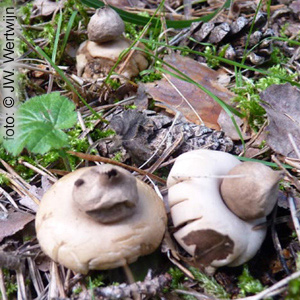
Photo: Fransche kamp,
September 11 2010
|
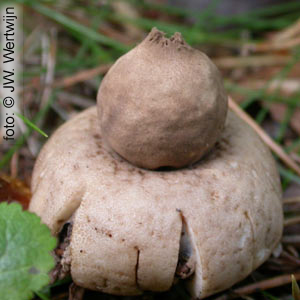
Photo: Fransche kamp,
September 11 2010
|
.jpg)
Photo: Sessile Earthstar
breaked out encrusted debris
|
Sessile Earthstar
(Geastrum fimbriatum Fries)
Syn.: Geastrum sessile (Sowerby) Pouzar.
NMV Ga 211040
Sessile Earthstar I learned from the dunal area. Natureguide Ton Puts (Oranjekom) told me
they have a lot of resemblance to Collared Earthstar. I could not image. Collared Earthstars are so much bigger and more ponderous in Diemen (as well the balloon, as well the star-rays are bigger) than Sessile Earthstar in the dunal coast area.
A Collared Earthstar I identified at the collar, at that time. All the other field-marks of Collared Earthstar I did not know, and even the fact
that there are sometimes other Earthstars with a collar was not part of my knowledge.
When Champignons in de Jordaan was published in 1999, I was surprised. At the last pages of the book natureguide Ton Puts was just mentioned as observer, just like me.
I expected him to be in the select group of mycologist controllers of observations. He knew so much more than I did.
Sessile Earthstars in the Spanderswoud (pleistocene area) were shocking. The resemblance with Collared Earthstar was striking.
And some of them indeed were Collared Earthstars, complete with curled (saccate) star-rays, and with a scar. But the adjacent others
were real Sesslile Earthstars, with encrusted debris, and without a scar. That much resemblance Ton Puts made me aware of in the Northsea dunal coast,
can be found in the pleistocene area.
|
|
Habitat
Sessile Earthstar is first of all a forest Earthstar, living in deciduous, coniferous and mixed wood.
Sessile Earthstar prefers sandy, loamy, clayi and calciferous soil
(and therefore you can find this Earthstar in the pleistocene area along bicycle tracks,
which were until 2005 hardened with calcareous sea-shells, and which are
since 2005 hardened with non-calcareous loam on top of the shells);
Outside the Netherlands Sesslie Earthstar also is growing in high-peat bogs.
Sessile Earthstar prefers fertile and less fertile soil (but than growing at places with humous piles),
at dry till more or less moisty places. Sessile earthstar in the Netherlands does not like marsh-land, and low-peat bogs.
Wood species:
Deciduous (Alm, Birch, Beech, Hawthorn, Maple, Oak, Sea Buckthorn)
Coniferous (abies, pinus)
|
.jpg)
Foto: Sessile Earthstar (bottom)
Spanderswoud, September 21 2008
|
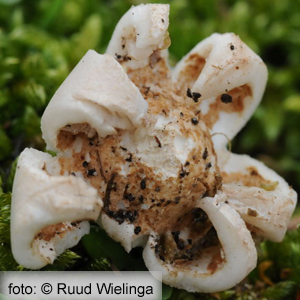
Foto: Felty Earthstar (bottom)
Meijendel, October 29 2010
|
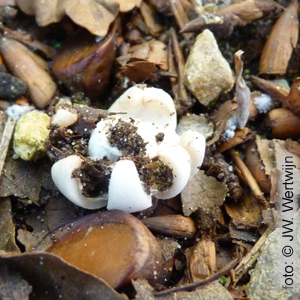
Foto: Sessile Earthstar (bottom)
Vuursche, October 31 2011
|
|
Mistakability:
Young Collared Earthstars can be taken for
Sessile Earthstars if the collar is not yet formed, the court is still hardly visible, the star-rays
are still curled (saccate) and the balloon is still deep down in the star-rays (cf. Jalink, 39,40).
Two differences to prevent you from a mistake:
- Collared Earthstar has no encrusted debris, Sessile Earthstar has
- Collared Earthstar has a scar, Sessile Erathstar does not have
Felty Earthstar (Geastrum saccatum)
is saccate (curled star-rays). Star-rays of Felty Earthstar are curled almost 180 degrees.
Felty Earthstar has a ring-furrowed mouth-zone and a scar under the star-rays, but no encrusted debris.
Elegant Earthstar (Geastrum elegans)
has encrusted debris and no scar, and has a non-limited conical plicate-furrowy mouth-zone.
Elegant Earthstar has young a striking resemblance with Sessile Earthstar,
but the balloon is higher than broad and the mouth-zone is conical plicated.
Rosy Earthstar (Geastrum rufescens)
cannot been mistaken, under normal conditions,
but years ago, on a mini-course of mushrooms, someone offered a so called Rosy Earthstar,
which was a Sessile Earthstar with a vague rosy shade.
Rufescens means 'becoming red'. A Rosy Earthstar is becoming red if you carve it with a finger nail.
Sessile Earthstar is not coloring red upon injuring,
but it can change brown-rosy at the open air (some kind of self-injuring color change).
And there are enough differences to prevent you for wrong conclusions:
- Sessile Earthstar has encrusted debris, Rosy Earthstar does not have.
- Sessile Earthstar does not change color if you injure it, Rosy Earthstar does.
- Sessile Earthstar has no stem, Rosy Earthstar has (when it is old).
|
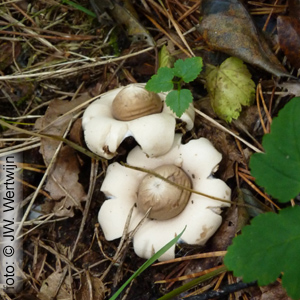
Photo: Sessile Earthstar
Vuursche, NMV-excursie,
October 31 2011
|
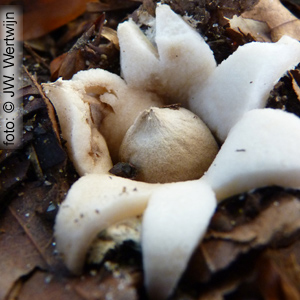
Photo: Sessile Earthstar
Vuursche, NMV-excursie,
October 31 2011
|
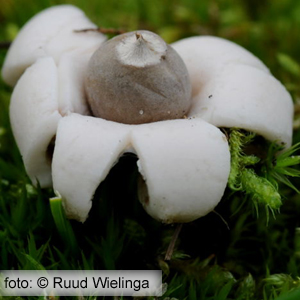
Photo: Felty Earthstar
Meijendel,
October 29 2010
|
|
Mistakability and Photography:
Pictures are more difficult than real earthstars. Bad weather, rainy, moisty, red-brown spores of other species, lack of light and contrast, forgotten pictrues of side and bottom)
Under such circumstances photo-observers often fail to report a certain observation. Such photo's only illustrate un uncertain, doubtful observation of earthstar-genus
Lots of observations of Sessile Earthstar are lacking a picture from the star-rays-bottom. It depends on the habitat-type if mistakability is possible.
Regional Mistakability:
In the Amsterdam Area mistakability is restricted to
Collared Earthstar and Sessile Earthstar,
and especially between the form-aberrations of this two species. This is possible in parks with mixed trees, like Gaasperpark (Sparrenbos).
In the pleistocene area both species can be found together along bycycle tracks through mixed wood (pinus and oak), and in areas with Beech lanes:
- Fransche kamp (bicycle track east of camping),
- Kivietsdal (bicycle track along Gooiersgracht),
- Vuursche Dreef (Stulpse laan), in Beech lane.
|
|
Field-Marks: See: Anatomy Genus Geastrum
- fruit-body: geen roodverkleuring bij beschadiging
- balloon-stem: no stem, no apophyse (you need old or dried earthstar for this observation)
- balloon mouth-zone: fibrillose, not limited (bald, not plicate-furrowy, no court, no ring-furrow)
- balloon mouth-zone: flat to low-conical
- balloon mouth-zone: sometimes a bit lighter colored "ring", but with a diffuse border
- star-rays-number: 6-10
- star-rays-form: saccate (almost 180 degrees curled down)
- star-rays-encrusted-debris: yes
- star-rays: if the encrusted debris gets unfixed, a glaring cream-white layer becomes visible
- star-rays-scar: no
Fimbriatum or fibrillose means without plicate, without furrowy mouth-zone, the name points
the absense of a mark. A worser description is "baldy radial fibres around the mouth-zone".
That description fails for certain fimbriate species growing stages, including Rosy Earthstar.
A better description of fibrillous is "covered with thin fibres"
|
Jalink (1995) offers macroscopic keys for dried earthstars. In the field, especially in the Northsea dunal coast area
Tablewise approaches (Jalink 19,20), are faster for recognistion by field-marks of fresh species.
An example:
- fibrillose earthstars ->
- Balloon with or without a stem, all without apophyse, all with encrusted debris ->
- Star-srays saccate, non-hygroscopic, fruit-body no color change upon injuring ->
- Sessile earthstar
|
Literature:
Chrispijn, R. ed. (1999), Champignons in de Jordaan (De paddenstoelen van Amsterdam), Schuyt en Co, 162-163.
Gerhardt (2006), De grote Paddenstoelen Gids (voor onderweg), Tirion Natuur, 616.
Hansen, L & K. Knudsen (1997), Nordic Macromycetes, Kopenhagen, Vol 3, 345.
Jalink (1995), De aardsterren van Nederland en België, Coolia 38 supplement, 59-60.
Pegler, e.o. (1995), British puffballs, earthstars and stinkhorns, an account of the british gasteroid fungi, Royal Botanic Gardens, kew, 1995, 255 pp.
Vermeulen (1999), Paddestoelen, Schimmels en Slijmzwammen van Vlaanderen, Wielewaal, Turnhout, 541.
www.mycobank.com
|
Top
|